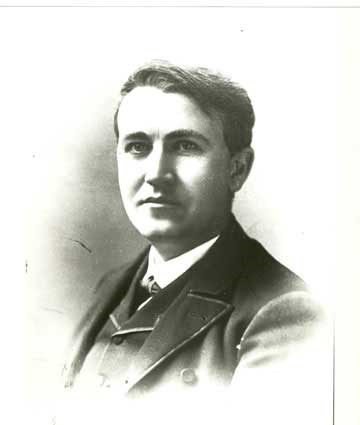
NPS Photo
People often say Edison was a genius. He answered, "Genius is hard work, stick-to-it-iveness, and common sense." Thomas Alva Edison was born February 11, 1847 in Milan, Ohio (pronounced MY-lan). In 1854, when he was seven, the family moved to Michigan, where Edison spent the rest of his childhood. "Al," as he was called as a boy, went to school only a short time. He did so poorly that his mother, a former teacher, taught her son at home. Al learned to love reading, a habit he kept for the rest of his life. He also liked to make experiments in the basement. Al not only played hard, but also worked hard. At the age of 12 he sold fruit, snacks and newspapers on a train as a "news butcher." (Trains were the newest way to travel, cutting through the American wilderness.) He even printed his own newspaper, the Grand Trunk Herald, on a moving train. At 15, Al roamed the country as a "tramp telegrapher." Using a kind of alphabet called Morse Code, he sent and received messages over the telegraph. Even though he was already losing his hearing, he could still hear the clicks of the telegraph. In the next seven years he moved over a dozen times, often working all night, taking messages for trains and even for the Union Army during the Civil War. In his spare time, he took things apart to see how they worked. Finally, he decided to invent things himself. After the failure of his first invention, the electric vote recorder, Edison moved to New York City. There he improved the way the stock ticker worked. This was his big break. By 1870 his company was manufacturing his stock ticker in Newark, New Jersey. He also improved the telegraph, making it send up to four messages at once.During this time he married his first wife, Mary Stilwell, on Christmas Day, 1871. They had three children -- Marion, Thomas, Jr., and William. Wanting a quieter spot to do more inventing, Edison moved from Newark to Menlo Park, New Jersey, in 1876. There he built his most famous laboratory. He was not alone in Menlo Park. Edison hired "muckers" to help him out. These "muckers" came from all over the world to make their fortune in America. They often stayed up all night working with the "chief mucker," Edison himself. He is sometime called the "Wizard of Menlo Park" because he created two of his three greatest works there. The phonograph was the first machine that could record the sound of someone's voice and play it back. In 1877, Edison recorded the first words on a piece of tin foil. He recited the nursery rhyme "Mary Had a Little Lamb," and the phonograph played the words back to him. This was invented by a man whose hearing was so poor that he thought of himself as "deaf"! Starting in 1878, Edison and the muckers worked on one of his greatest achievements. The electric light system was more than just the incandescent lamp, or "light bulb." Edison also designed a system of power plants that make the electrical power and the wiring that brings it to people's homes. Imagine all the things you "plug in." What would your life be like without them? In 1885, one year after his first wife died, Edison met a 20-year-old woman named Mina Miller. Her father was an inventor in Edison's home state of Ohio. Edison taught her Morse Code. Even when others were around, the couple could "talk" to each other secretly. One day he tapped a question into her hand: would she marry him? She tapped back the word "yes." Mina Edison wanted a home in the country, so Edison bought Glenmont, a 29-room home with 13-1/2 acres of land in West Orange, New Jersey. They married on February 24, 1886 and had three children: Madeleine, Charles and Theodore. A year later, Edison built a laboratory in West Orange that was ten times larger than the one in Menlo Park. In fact, it was one of the largest laboratories in the world, almost as famous as Edison himself. Well into the night, laboratory buildings glowed with electric light while the Wizard and his "muckers" turned Edison's dreams into inventions. Once, the "chief mucker" worked for three days straight, taking only short naps. Edison earned half of his 1,093 patents in West Orange. But Edison did more than invent. Here Edison could think of ways to make a better phonograph, for example, build it with his muckers, have them test it and make it work, then manufacture it in the factories that surrounded his laboratory. This improved phonograph could then be sold throughout the world. Not only did Edison improve the phonograph several times, but he also worked on X-rays, storage batteries, and the first talking doll. At West Orange he also worked on one of his greatest ideas: motion pictures, or "movies." The inventions made here changed the way we live even today. He worked here until his death on October 18, 1931, at the age of 84. By that time, everyone had heard of the "Wizard" and looked up to him. The whole world called him a genius. But he knew that having a good idea was not enough. It takes hard work to make dreams into reality. That is why Edison liked to say, "Genius is 1% inspiration and 99% perspiration." |
Last updated: February 26, 2015
